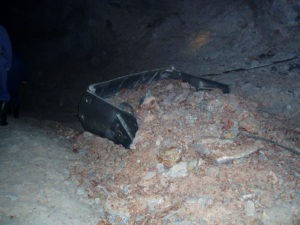
Having worked with the potash industry for many years, I have reviewed numerous geological reports for projects in Canada, Asia, Russia, and Africa. One of the curious things that I have seen is the reporting of resource grades in two different units; either as potassium oxide (K2O) or potassium chloride (KCl).
Is it K2O or KCl ?
Standard practice in the Saskatchewan industry is reporting ore grades using K2O units, with typical head grades in the range of 25% K2O. Many of the international projects, but not all, have decided to use the KCl units. Therefore when comparing potash resource grades between deposits, one must be vigilant for the units used since there is a significant difference.
The conversion from K2O to KCl is based on the formula K2O = 0.6317 x KCl. So a grade of 25% K20 is equal to 25/0.6317 = 39.6% KCl. The KCl grade value is significantly higher. The unit issue is relevant with low grade deposits, were an actual grade of 15% K2O may be reported as 23.7% KCl. One might see the ore grade in KCl and assume it is comparable to Saskatchewan potash grades, when in reality they are quite different.
Concentration Ratio is the Key
When looking at different potash projects, particularly those involving underground mining, a key economic factor is the concentration ratio. This ratio represents the tonnes of potash ore needed to produce a tonne of final saleable product.
Typically the final potash product has a grade of 60% K2O. Therefore a potash ore with a grade of 25% K2O would have a concentration ratio of about 2.4:1 (60%/25%). This means that 2.4 tonnes of potash must be processed to produce 1 tonne of product (ignoring the process recovery factor). For a lower grade ore with a head grade of say 15% K2O, the concentration ratio is 4:1 (60%/15%).
This gives a rough sense for the comparable operation size required to meet the same final product production levels. This also gives a indication for the relative amounts of salt tailings requiring disposal. Low grade ore can generate significant quantities of tailings, the disposal of which is becoming a larger permitting issue.
In the past gold grades have been reported as “oz/ton” or currently as “g/t”, but most geological reports today are consistent with “g/t”. Sometimes US based gold projects may use “oz/ton” however the magnitude in reported grades are fairly obvious between grams and ounces. That isn’t the case with potash grades.
The bottom line is that potash is one commodity that will use different units when reporting ore grades. Investors and reviewers must be aware of which units are being used.
If you are into potash mining, I have written a couple of blog posts about my brief, but interesting, time working at a potash mine in Saskatchewan. This was early in my career and I had roles that included mine engineer, chief mine engineer and production foreman. Each of these roles gave me a different perspective about a mining operation. In this two part blog, I share some stories relating to the uniqueness of potash mining. If interested, here is the link “Stories from 3000 Feet Down – Part 1“.
Note: If you would like to get notified when new blogs are posted, then sign up on the KJK mailing list on the website. Otherwise I post notices on LinkedIn, so follow me at: https://www.linkedin.com/in/kenkuchling/.



Those sorts of issues exist with many different minerals. Is a company reporting Mo or MoS2? I know of a Canadian gold mine that was still reporting pennyweight/ton a decade or so ago. The one that bothers me the most is equivalent grade. Some projects use it to convert polymetallic mineralization to one metal. Copper equivalent is one variant. My bottom line is to read carefully and understand what you are reading when these issues arise.
Good point about the Mo and MoS2. I have been caught on that one in the past. Another less common is tungsten grade being reported as WO3 or W, but I think WO3 is used most of the time now. Maybe there are more of these out there.
I also don’t like the use of metal equivalents; NSR dollar value is my preference ( http://kuchling.com/metal-equivalent-grade-versus-nsr-for-multi-metals-preference/).
Yeah, tungsten! I dislike the way it’s sold in MTU’s.